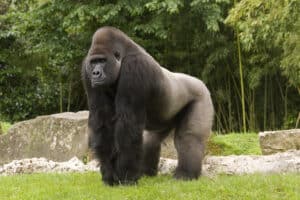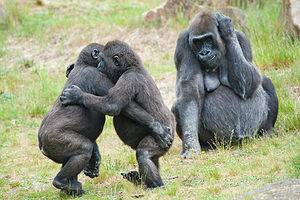The largest land animal is the elephant, and the largest animal on the planet is the blue whale, but have you ever watched King Kong and wondered about the largest primates? If so, you’re in the right place. Let’s discover the largest primate in the world and find out just how large it gets.
The Largest Primate in the World
The world’s largest primate is the eastern lowland gorilla, or Gorilla beringei graueri. It’s a critically endangered subspecies of gorilla and the largest primate in the world that currently exists.
Eastern lowland gorillas can stand 5-6 feet tall, so they are comparable in height to humans, but they have 450-500 pounds of solid muscle. That’s comparable to a male grizzly bear, a baby grand piano, or a loaded vending machine.
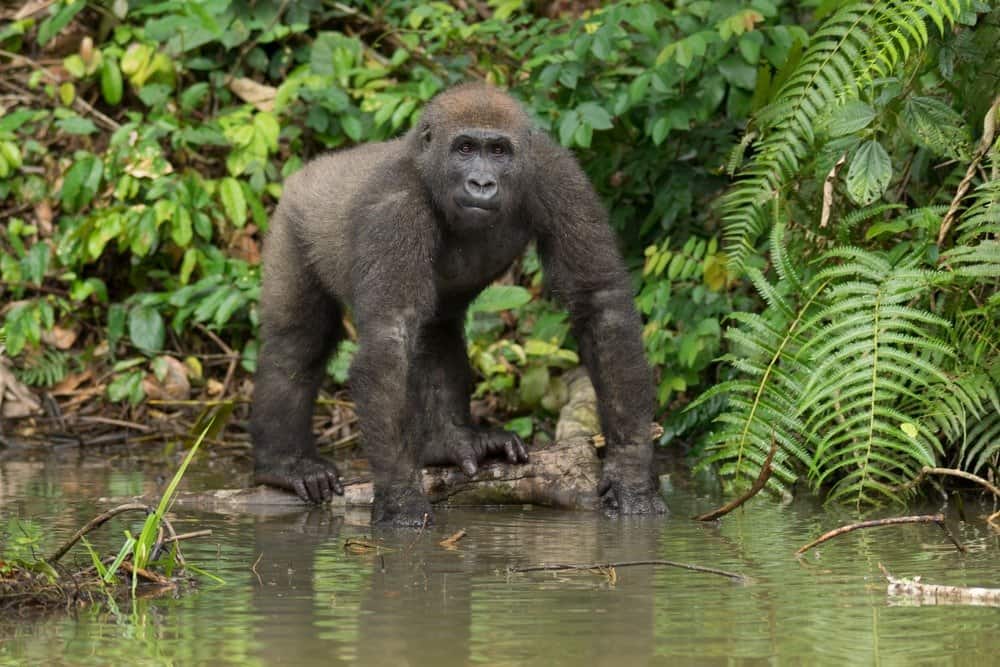
Eastern lowland gorillas can stand 5-6 feet tall, so they are comparable in height to humans, but they have 450-500 pounds of solid muscle.
©Vaclav Sebek/Shutterstock.com
What Is a Primate?
Primates are an order of mammals divided into strepsirrhines (lemurs, galagos, lorisids) and haplorhines of simians and tarsiers. Humans and gorillas are simians.
Primates are characterized by large brains for their size, reliance on sight rather than scent, and dexterous hands.
The smallest primate is Madame Berthe’s mouse lemur, Microcebus berthae, which weighs only one ounce. It was only discovered in 1992 in Madagascar.
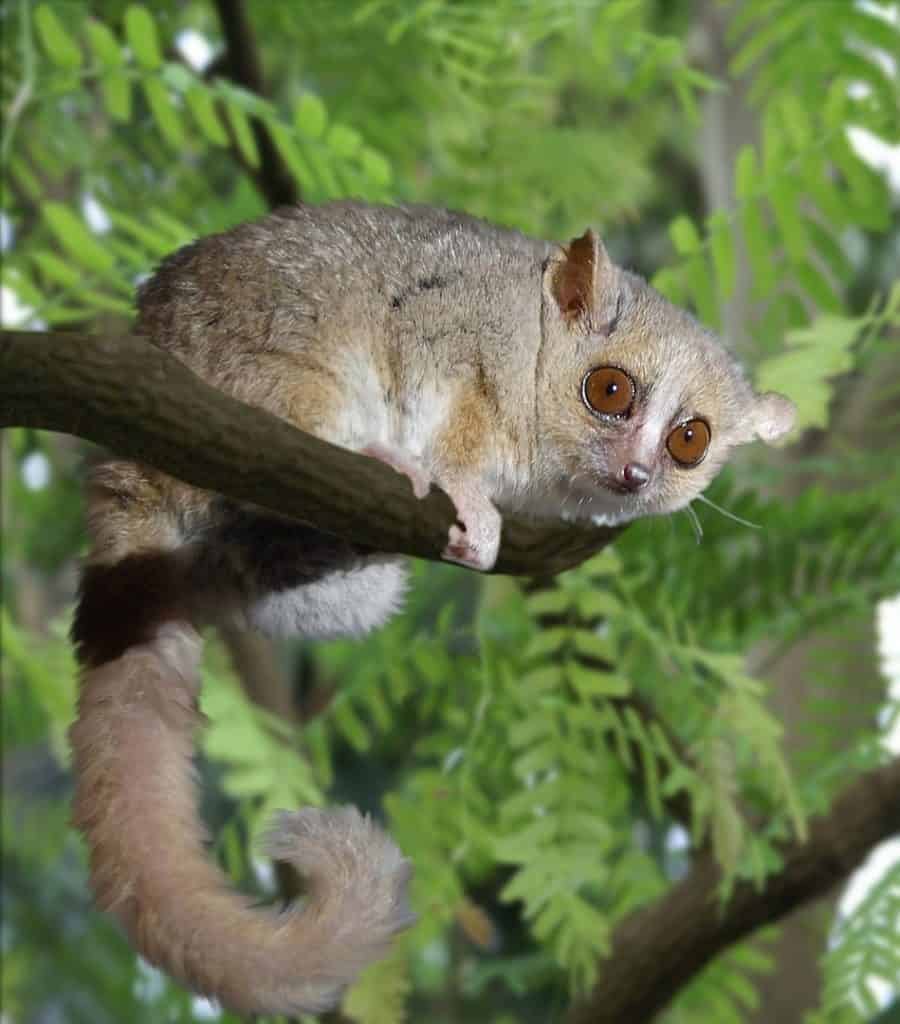
The smallest primate is the adorable mouse lemur.
©photographer: Gabriella Skollar; editor: Rebecca Lewis / CC BY-SA 3.0 – License
Eastern Lowland Gorilla: Largest Primate
The eastern lowland gorilla is one of two eastern gorilla subspecies. The other species is the mountain gorilla (Gorilla beringei beringei), which tends to be a little smaller than eastern lowland gorillas.
Another name for the world’s largest living primate is Grauer’s gorilla, after the Austrian scientist who discovered them in the 1900s. Beringei means ‘Kivu Highlands,’ so the eastern lowland gorillas’ scientific name is Gorilla beringei graueri, which means Grauer’s Kivu Highlands gorilla.
How Big Is an Eastern Lowland Gorilla?
Eastern lowland gorillas weigh between 450 -500 pounds and stand up to 6 feet tall. Males are larger than females, but both can run at 25 mph and live for 60 years in captivity. In the wild, 35-50 years old are more common unless they are injured or poached.
They are the largest primates, so it’s no surprise they are strong, too. They have a high muscle mass ratio compared to the rest of their frame. The largest, strongest males compete to lead the troupe.
Eastern lowland gorillas are tall, weighty, and strong, and they are covered in hair (except their faces, hands, and feet) that ranges from gray to brown and black. The largest males develop a silver sheen on their backs and shoulders, so they are referred to as silverbacks. For extra warmth, eastern lowland gorillas have a super thick layer of skin and a good fat covering.
They differ from the smaller mountain gorilla cousins because they have larger hands and longer arms but shorter muzzles, teeth, and hair. Like all gorillas, eastern lowlands like to walk on their knuckles.
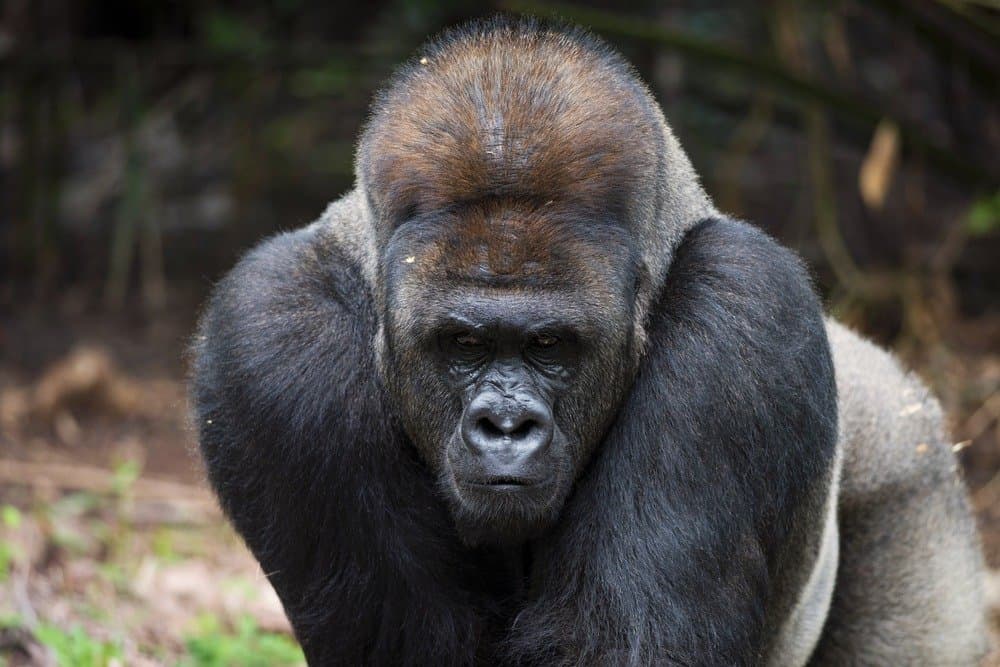
Gorillas are strong mammals because they have a high muscle mass ratio compared to the rest of their frame.
©dptro/Shutterstock.com
Where Do They Live?
The largest primate in the world only lives in tropical lowland rainforests of the Eastern Democratic Republic of Congo (DRC). Most live in the lowland and Albertine Rift montane forests.
The Largest Primate Is an Omnivore!
Despite their massive size and strength, the largest primate in the world is not a terrifying carnivore but an omnivore. They enjoy eating a wide range of fruits, berries, leaves, and nuts and supplement them with insects like termites and ants. Some observers have spotted them eating lizards and small rodents, too.
Because they have such strong jaws and teeth, eastern lowland gorillas can chew fibrous tree barks and the majority of rainforest vegetation. An adult needs 40 lbs. of food each day.
Family Life
Most primates are social animals, so the largest primate in the world lives in a family group called a troop or band. It’s led by a large male, with several females and their young. Sometimes, young males are included, but they are subordinates. If they challenge the leader or attempt to mate with the females, they are ejected. Researchers have counted up to 30 individuals in one troop. Very rarely, a troop is led by two silverback males. When males reach sexual maturity, around 15-20, they leave to start their own troop.
The troop eats, travels, and sleeps together. They are peaceful animals, although the dominant silverback must sometimes fight to keep his position. To keep order, the Silverback leader decides when they travel, feed, and sleep.
These gorillas are usually quiet, but they can be chatty creatures. They have over 25 vocalizations that include laughing, growling, hooting, and screaming.
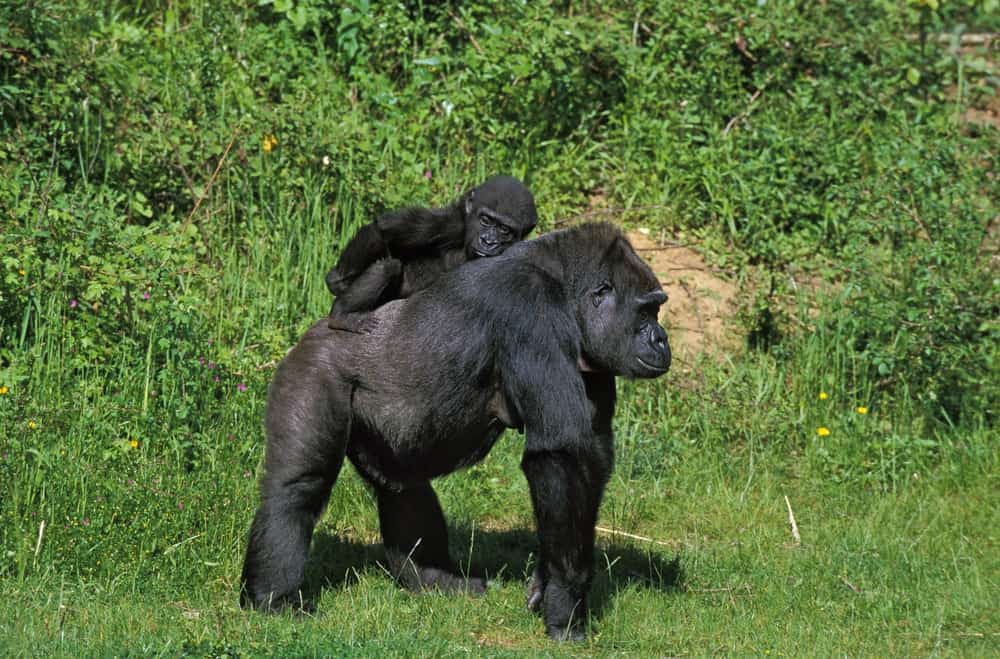
Troops or bands are led by a large male, with several females and their young.
©slowmotiongli/Shutterstock.com
Intelligence
These primates have large brains. They are capable of communication, teamwork, using tools (such as sticks to extract juicy ants), and sign language to communicate with humans.
Are They Going Extinct?
Yes, the world’s largest primate is listed as critically endangered by the Red List of the International Union for Conservation of Nature.
Experts estimate the population size has shrunk by at least one quarter, even up to 50%, in the last 50 years. There were 17,000 in the 1990s, but researchers think there are much fewer now. Getting an accurate count is difficult due to civil unrest, upheaval, and violence in the DRC.
The endangered eastern lowland gorillas’ habitat now only stretches to around 4600 square miles, just under half its natural range in the 1990s.
They are endangered because their habitat is shrinking, and what’s left is fragmented, meaning they can’t safely travel. Rainforest habitat is destroyed by farming clearance, livestock land, and illegal mining for diamonds, tin, gold, and coltan. Coltan is an alloy used in cell phones, and it’s in high demand.
Miners and hunters kill eastern lowland gorillas for bushmeat, the medical trade, and sell infant gorillas into the illegal wildlife pet trade.
Even though there are protected areas in Kahuzi-Biega National Park, poachers and rebels are still able to kill them because preserving the area is so dangerous for rangers and volunteers.
Where to See the Largest Primate
If you want to see the largest primate in the world, you’ll have to travel to Antwerp Zoo in Belgium. They have two female eastern lowland gorillas there called Victoria and Amahoro. Additionally, the San Diego Zoo runs a conservation program in central Africa to protect all gorilla species.
Gigantopithecus: The Largest Primate that Ever Lived
Eastern lowland gorillas are the largest primates currently living, but paleontologists think Gigantopithecus was the largest ever primate.
This massive, extinct ape lived in modern-day China over 100,000 years ago and died out in the Pleistocene era because it was so huge. In the final years of Gigantopithecus’ reign, the climate changed, and an Ice Age smothered the land. This unfortunate ape couldn’t adjust, and experts think it couldn’t find enough food to sustain itself.
Gigantopithecus remains were first discovered in a Chinese drugstore by anthropologist Ralph von Koenigswald in 1935. He found two-thirds of molars being sold as dragon teeth!
In 1956, a mandible was uncovered, along with over 1000 teeth. From the little remains available, it is estimated that Gigantopithecus weighed 440-660 lbs. and was an herbivore that ate forest plants. If the largest estimate is correct, Gigantopithecus would outweigh eastern lowland gorillas by 260 lbs.!
Anthropologists think this primate was related to orangutans, so it’s classified in the subfamily Ponginae.
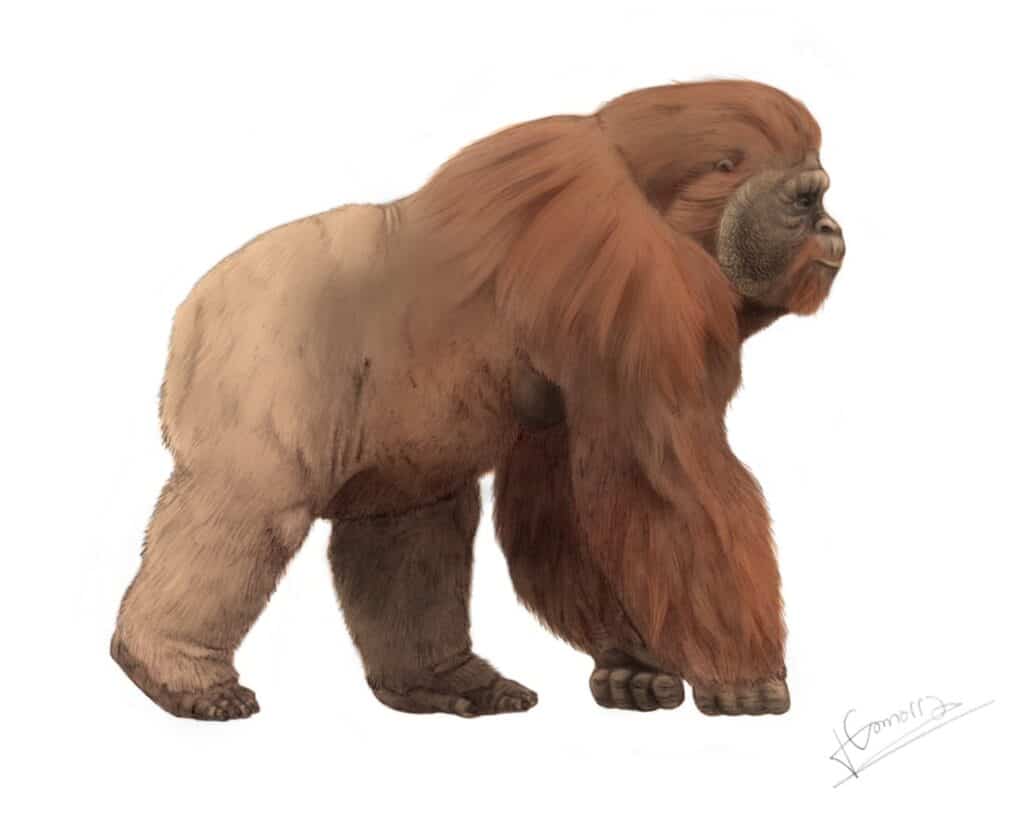
This massive, extinct ape lived in modern-day China over 100,000 years ago and died out in the Pleistocene era because it was so huge.
©Concavenator / CC BY-SA 4.0, , via Wikimedia Commons – License
The World’s Largest Primate: Eastern Lowland Gorilla
On our quest to discover the largest primate in the world, we’ve found that Gorilla beringei graueri (otherwise known as Grauer’s gorilla or the eastern lowland gorilla) is the largest living primate, weighing in at around 500 lbs. and standing up to 6 feet tall.
Sadly, this spectacular primate is critically endangered in its Democratic Republic of Congo habitat and is still under threat today.
The photo featured at the top of this post is © PhotocechCZ/Shutterstock.com
Thank you for reading! Have some feedback for us? Contact the AZ Animals editorial team.




